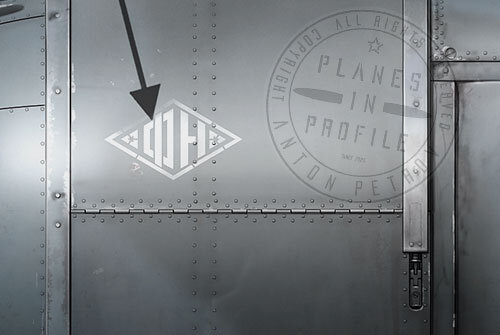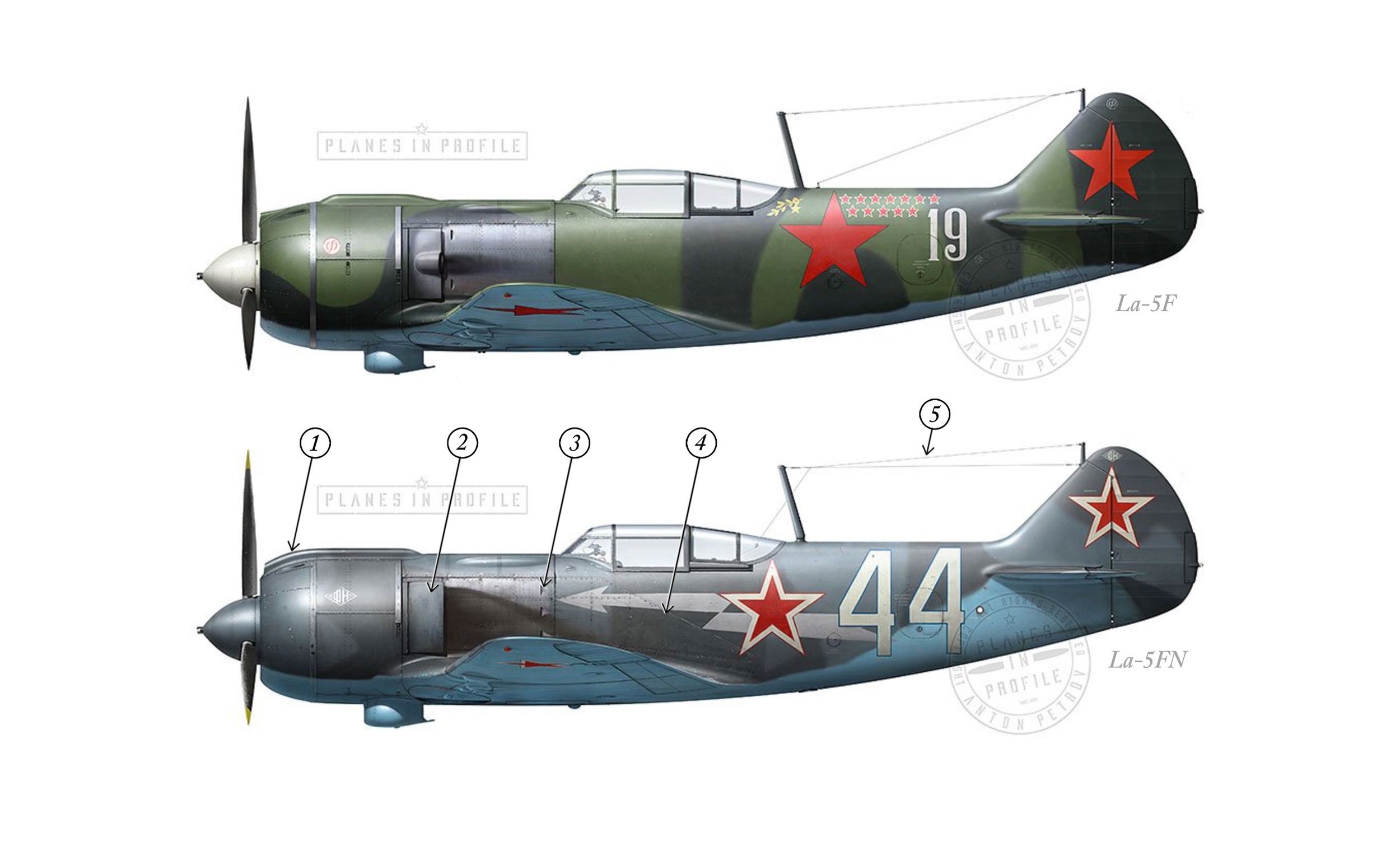(Lavochkin)
La-5FN
La-5FN was the second and the most successful modification of the La-5 variant, designed by the Lavochkin bureau. It entered production in 1943, with 4817 La-5FNs built in total [1].
La-5FN used the La-5F’s Type-39 body as a base, with added improvements. La-5FN’s main improvement over the La-5 and La-5F, was the ASh-82FN Engine. The ‘F’ in the ‘FN’ designation stood for ‘Forsirovaniy’ which translates to ‘Forced or Boosted’ and ‘N’ stood for ‘Neposredstvenniy’ meaning ‘Neposredstvenniy vprisk' which translates to ‘Direct injection’. This was an engine in which a carburator (still being used in the engines of the previous La-5 models) was replaced for a direct fuel injection system, which improved the engine’s performance and power. The symbol ‘ФH’ which is the cyrillic letters ‘FN’ , inclosed in a rhombus, was painted in white onto the engine cowling and the tip of the tail of the airplanes to help identify them as La-5FN.
Cyrillic letters ‘FN’ ,inclosed in a rhombus, were painted on the engine cowlings of the La-5FN airplanes.
The ‘FN’ symbol also appeared on the tip of the tail .
It is worth noting that even though the La-5FN is generally considered to be an improvement over the La-5F, it has not replaced the La-5F modification. Even though the La-5FN entered production after the La-5F, the two variants were built alongside each other and the latest improvements were implemented into both designs. So the improvements discussed in the La-5F section, were also implemented into the La-5FN. Such improvements as for example the increased surface area and the change to the angle of turn of the elevators, or liquidation of the trimmer on the starboard side elevator, or the emergency release system for the moving part of the canopy, or the pneumatic fire control which was replaced in both variants with pneuma-electric (though it was changed back to pneumatic later on), and various other modifications. However, there are a few fundamental differences apart from the engine in the two variants, and these can be seen at a glance. Visually, the new engine gave the La-5FN a larger supercharger air intake on top of the engine cowling, the cowl flaps were modified because the exhaust pipes were separated from combined into individual , and the plane was fitted with metal heat protection panels on the sides of the fuselage, these are just the most noticeable differences between the two variants.
The main visual characteristics which differentiate the La-5FN design from the La-5F:
1)Larger air intake, 2) Redesigned cowl flap to fit the new exhaust pipe arrangement, 3) Air vents relocated to the back of the exhaust panel, 4) Heat protection panels added to the sides of the fuselage, 5) Antena wires arrangement was often different, but not always.
The planes of the La-5FN modification made their first appearance, though in small numbers, above the battlefields in the summer of 1943, which coincided with the Germans bringing out their own latest modifications of fighters such as Focke Wulf FW-190. These latest fighter modifications clashed above the skies of Kursk in the summer of that year (The largest air battle in history based on the amount of airplanes amassed for the battle), with both sides relying on their new machines to help them achieve air superiority above the battlefield. During the course of the Kursk battles however, La-5FN proved to be equal to, and even superior to the latest German fighters at low altitudes in some respects, in a tighter turn radius or in speed at tree-top level (according to some sources) for example. This was an unpleasant surprise for the Germans who realised that they no longer had technological superiority over the Soviet fighters which they enjoyed in the first two years of fighting.
La-5FNs were distributed to the combat units along the whole stretch of the Eastern Front and were in use until the very end of the war, even after they were superseded by the La-7 variant in late 1944. La-5FNs remained in service even after the war and not just by the Soviet VVS, they were also used by Czechoslovakian Air Forces. La-5FNs were flown by some of the best Allied fighter pilots of WW2, including Kirill Evstigneev and Ivan Kozhedub (number 5 and number 1 top-scoring Allied Fighter Aces based on personal victories). It was the most successful version of the La-5 variant and one of the greatest fighter planes of WW2 amongst its contemporaries.
Specifications [3]
GENERAL CHARACTERISTICS
Crew: 1
Length: 8.67 m
Wingspan: 9.76 m
Height: 2.54 m
Wing area: 17.51 m2
Gross weight: 3,322 kg
Powerplant: 1 × Shvetsov M-82FN
PERFORMANCE
Maximum speed: 620 km/h at 6,500 m, 542 km/h at sea level
Range: 775km
Service ceiling: 11,000m
Rate of climb: 1000 m/min
ARMAMENT
Guns: 2 × 20 mm ShVAK cannon
Bombs: 2 × bombs, up to 100 kg each (FAB-100)
[1] The number of La-5FNs built is taken from the book called ‘Lavočkin La-5’ by Miloš Veštšik, page 39. Published by MBI in 2006.
[2] It’s worth noting that even though La-5F was designed before La-5FN and even though The FN’s engine was an improvement of the F’s engine, the latter airplane modification was not exactly a successor of the former. Both La-5FN and La-5F were produced concurrently for much of their time and design improvements (other than the engine) were implemented into both airplane modifications at the same time.
[4] Specifications are derived from various sources. “Performance” specifications are derived from the book called ‘Lavochkin La-5’ by Miloš Veštšík, published by MBI in 2006. Page 108




